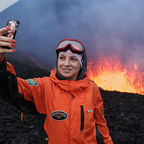Media
Selfies Kill More People Than Sharks Do
Inattention and a need to show off are the biggest killers of all
Posted December 25, 2015

In 2015, nineteen people were killed in selfie-related incidents, and many more injured themselves. During the same period, eight people died of shark attacks.
How did we reach the point where the need to show off on social media outweighs common sense for seeing danger and the instinct for self-preservation?
Self-absorbed selfie shooters have fallen from cliffs, crashed their cars, and electrocuted themselves while posing for their followers atop train cars. Three college students died while trying to snap a selfie in front of an oncoming train. Others have shot and killed themselves while posing with guns. In a spectacular blowout, two Russians in the Urals posed with a hand grenade with the pin pulled out. The photograph survived as evidence of their inattention. A distracted Cessna pilot in Colorado lost control of his plane and killed its occupants. In Portugal a Polish couple fell from a cliff into the ocean after stepping over a safety barrier to take a selfie with their two children, who lived to witness their parents’ death. Seven youths drowned on a lake in India when their boat tipped over as they stood up to pose for pictures.
While taking a selfie in Yogyakarta, Indonesia, a young man fell into the crater of Mount Merapi, an active volcano. Nearby off the coast of Bali, a tourist fell into the sea while snapping himself on a picturesque cliff. In Moscow a graduate student fell from a bridge while attempting to capture herself in a dramatic pose. Another young Russian angling for a trophy shot fell to his death while hanging from a nine-story building. At the Taj Mahal a Japanese tourist photographing himself fell down a staircase to his death.
“Nobody wants to be outdone,” says psychology professor Zlatan Krizan of Iowa State University. But outdoing others is what social media has become all about. The theory of “social comparison,” by which people measure their personal and social worth against how they stack up to others, dates from 1954. But in today’s culture of “Pics or it didn’t happen,” a photo showing you front and center proves that you were in a particular place at a particular time doing enviable things. As the standard for what counts as interesting escalates, the risks people take in order to make an impression intensify.
The Russian Interior Ministry launched a multimedia campaign for “safe selfies,” pleading that “Even a million ‘likes’ on social media are not worth your life and well-being.” When people take a picture of themselves, they warn, they become distracted, lose their balance, don’t look around, and “don’t feel themselves in danger.” This is common sense, but common–sense warnings fall on deaf ears.
For years the National Park Service has implored visitors to keep their distance from wildlife no matter how tame the animals appear. The Disneyfication of nature has instilled a false sense that animals are cute and will respond to our friendly gestures. The reality is that bison have lived continuously in Yellowstone since prehistoric times. Yet tourists seem determined to post selfies with bison, moose, and bears. They approach within feet of a 2,000 pound animal, and each year several get gored.
An Instagram search for #drivingselfie yields thousands of results. At any given moment in the daytime approximately 660,000 Americans behind the wheel are using cellphones or other electronic devices. Cell phone use causes one in four car accidents.
The dangers of cellphone distraction even extend to walking. We have all seen distracted people walking into lampposts and telephone poles. Hospital data analyzed by Ohio State University found that injuries involving cell phone use while walking more than doubled between 2005 and 2010. This rising trend in risky behavior has led some institutions to take preventative measures: Utah Valley University has created a separate stairway lane for slow–moving texters.
In my forthcoming book ab out digital distractions I talk about digital devices in the framework of addiction. I show how what are called behavioral addictions are no different, as far as the brain is concerned, from the physical kind.
The attention one gets from postings online—the likes, the comments, the number of retweets and new followers—is emotionally satisfying. It feels great, like a payout from a slot machine that makes you want to keep paying in hopes of getting another hit.
A university researcher who has studied frequent selfie–takers explains that they think, “I’m getting the confirmation from other people that I’m awesome” [paper title?]. He finds, not surprisingly, that such people score high on traits of narcissism and psychopathy. They focus more on personal gain in dangerous situations than on the danger itself. “You don’t care about the tourist attraction you’re destroying,” or that “You’re dangling off the side of the Eiffel tower.”
And this is how selfies kill more people than sharks do.
E-mail Dr. Cytowic for his low-frequency newsletter or for a copy of his American Interest article, "Digital Distractions: Your Brain on Screens." Follow @Cytowic, or visit Cytowic.net, LinkedIn, or his Facebook page.




